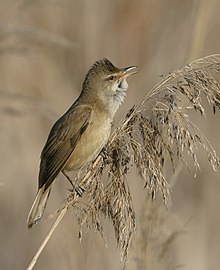Acrocephalus (bird)
Acrocephalus (bird)
Jump to navigation
Jump to search
Acrocephalus | |
|---|---|
 | |
Great reed warbler, Acrocephalus arundinaceus | |
Scientific classification | |
| Kingdom: | Animalia |
| Phylum: | Chordata |
| Class: | Aves |
| Order: | Passeriformes |
| Family: | Acrocephalidae |
| Genus: | Acrocephalus J. A. Naumann and J. F. Naumann, 1811 |
Species | |
About 35, see text. | |
The Acrocephalus warblers are small, insectivorous passerine birds belonging to the genus Acrocephalus. Formerly in the paraphyletic Old World warbler assemblage, they are now separated as the namesake of the marsh and tree warbler family Acrocephalidae. They are sometimes called marsh warblers or reed warblers, but this invites confusion with marsh warbler and reed warbler proper, especially in North America, where it is common to use lower case for bird species.
These are rather drab brownish warblers usually associated with marshes or other wetlands. Some are streaked, others plain. Many species breeding in temperate regions are migratory.
This genus has heavily diversified into many species throughout islands across the tropical Pacific. This in turn has led to many of the resulting insular endemic species to become endangered. Several of these species (including all but one of the species endemic to the Marianas and two endemic to French Polynesia) have already gone extinct.
The most enigmatic species of the genus, the large-billed reed warbler (A. orinus), was rediscovered in Thailand in March, 2006; it was found also in a remote corner of Afghanistan in the summer of 2009. Prior to these recent sightings, it had been found only once before, in 1867.
Many species have a flat head profile, which gives rise to the group's scientific name. The genus name Acrocephalus is from Ancient Greek akros, "highest", and kephale, "head". It is possible that Naumann and Naumann thought akros meant "sharp-pointed".[1]
Contents
1 List of species in taxonomic order
2 References
3 Further reading
4 External links
List of species in taxonomic order[edit]

This Eurasian reed warbler is raising the young of a common cuckoo.
Moustached warbler, Acrocephalus melanopogon
Aquatic warbler, Acrocephalus paludicola
Sedge warbler, Acrocephalus schoenobaenus
Speckled reed warbler, Acrocephalus sorghophilus
Black-browed reed warbler, Acrocephalus bistrigiceps
Paddyfield warbler, Acrocephalus agricola
Manchurian reed warbler, Acrocephalus tangorum (sometimes included in A. agricola)
Blunt-winged warbler, Acrocephalus concinens
Eurasian reed warbler, Acrocephalus scirpaceus
African reed warbler, Acrocephalus baeticatus
Blyth's reed warbler, Acrocephalus dumetorum
Marsh warbler, Acrocephalus palustris
Great reed warbler, Acrocephalus arundinaceus
Oriental reed warbler, Acrocephalus orientalis
Clamorous reed warbler, Acrocephalus stentoreus
Large-billed reed warbler, Acrocephalus orinus
Basra reed warbler, Acrocephalus griseldis
Australian reed warbler, Acrocephalus australis- †Nightingale reed warbler, Acrocephalus luscinius
Saipan reed warbler, Acrocephalus hiwae- †Aguiguan reed warbler, Acrocephalus nijoi
- †Pagan reed warbler, Acrocephalus yamashinae
- †Mangareva reed warbler, Acrocephalus astrolabii
Carolinian reed warbler, Acrocephalus syrinx
Nauru reed warbler, Acrocephalus rehsei
Millerbird, Acrocephalus familiaris
Bokikokiko, Acrocephalus aequinoctialis
Tahiti reed warbler, Acrocephalus caffer
Moorea reed warbler, Acrocephalus longirostris- †Garrett's reed warbler, Acrocephalus musae
Tuamotu reed warbler, Acrocephalus atyphus
Rimatara reed warbler, Acrocephalus rimatarae
Pitcairn reed warbler, Acrocephalus vaughani
Henderson reed warbler, Acrocephalus taiti
Northern Marquesan reed warbler, Acrocephalus percernis
Southern Marquesan reed warbler, Acrocephalus mendanae
Cook reed warbler, Acrocephalus kerearako
Greater swamp warbler, Acrocephalus rufescens
Cape Verde warbler, Acrocephalus brevipennis
Lesser swamp warbler, Acrocephalus gracilirostris
Madagascar swamp warbler, Acrocephalus newtoni
Rodrigues warbler, Acrocephalus rodericanus
Seychelles warbler, Acrocephalus sechellensis
Fragmentary fossil remains from the Late Miocene (about 11 mya) of Rudabánya (NE Hungary) show some apomorphies typical of this genus.[2] Given its rather early age (most Passerida genera are not known until the Pliocene), it is not too certain that it is correctly placed here, but it is highly likely to belong to the Acrocephalidae at the least.
References[edit]
^ Jobling, James A (2010). The Helm Dictionary of Scientific Bird Names. London: Christopher Helm. p. 30. ISBN 978-1-4081-2501-4..mw-parser-output cite.citationfont-style:inherit.mw-parser-output qquotes:"""""""'""'".mw-parser-output code.cs1-codecolor:inherit;background:inherit;border:inherit;padding:inherit.mw-parser-output .cs1-lock-free abackground:url("//upload.wikimedia.org/wikipedia/commons/thumb/6/65/Lock-green.svg/9px-Lock-green.svg.png")no-repeat;background-position:right .1em center.mw-parser-output .cs1-lock-limited a,.mw-parser-output .cs1-lock-registration abackground:url("//upload.wikimedia.org/wikipedia/commons/thumb/d/d6/Lock-gray-alt-2.svg/9px-Lock-gray-alt-2.svg.png")no-repeat;background-position:right .1em center.mw-parser-output .cs1-lock-subscription abackground:url("//upload.wikimedia.org/wikipedia/commons/thumb/a/aa/Lock-red-alt-2.svg/9px-Lock-red-alt-2.svg.png")no-repeat;background-position:right .1em center.mw-parser-output .cs1-subscription,.mw-parser-output .cs1-registrationcolor:#555.mw-parser-output .cs1-subscription span,.mw-parser-output .cs1-registration spanborder-bottom:1px dotted;cursor:help.mw-parser-output .cs1-hidden-errordisplay:none;font-size:100%.mw-parser-output .cs1-visible-errorfont-size:100%.mw-parser-output .cs1-subscription,.mw-parser-output .cs1-registration,.mw-parser-output .cs1-formatfont-size:95%.mw-parser-output .cs1-kern-left,.mw-parser-output .cs1-kern-wl-leftpadding-left:0.2em.mw-parser-output .cs1-kern-right,.mw-parser-output .cs1-kern-wl-rightpadding-right:0.2em
^ Bernor R.L.; Kordos L.; Rook L. (2002). "Recent Advances on Multidisciplinary Research at Rudabánya, Late Miocene (MN9), Hungary: a compendium" (PDF). Palaeontographia Italica (89): 3–36.
Further reading[edit]
Olsson, U.; Rguibi-Idrissi, H.; Copete, J.L.; Arroyo Matos, J.L.; Provost, P.; Amezian, M.; Alström, P.; Jiguet, F. (2016). "Mitochondrial phylogeny of the Eurasian/African reed warbler complex (Acrocephalus, Aves). Disagreement between morphological and molecular evidence and cryptic divergence: A case for resurrecting Calamoherpe ambigua Brehm 1857". Molecular Phylogenetics and Evolution. 102: 30–44. doi:10.1016/j.ympev.2016.05.026.
External links[edit]
| Wikimedia Commons has media related to Acrocephalus. |
Acrocephalus videos on the Internet Bird Collection
Categories:
- Acrocephalus
- Bird genera
(window.RLQ=window.RLQ||).push(function()mw.config.set("wgPageParseReport":"limitreport":"cputime":"0.568","walltime":"0.743","ppvisitednodes":"value":7651,"limit":1000000,"ppgeneratednodes":"value":0,"limit":1500000,"postexpandincludesize":"value":29567,"limit":2097152,"templateargumentsize":"value":5392,"limit":2097152,"expansiondepth":"value":11,"limit":40,"expensivefunctioncount":"value":16,"limit":500,"unstrip-depth":"value":1,"limit":20,"unstrip-size":"value":6955,"limit":5000000,"entityaccesscount":"value":16,"limit":400,"timingprofile":["100.00% 687.383 1 -total"," 55.98% 384.828 1 Template:Automatic_Taxobox"," 54.69% 375.910 1 Template:Taxobox/core"," 16.48% 113.308 1 Template:Taxonbar"," 11.78% 80.984 1 Template:Reflist"," 11.36% 78.056 45 Template:Delink"," 8.89% 61.104 1 Template:Cite_book"," 8.21% 56.449 1 Template:Commons_category"," 4.89% 33.630 2 Template:Cite_journal"," 3.42% 23.483 1 Template:Italic_title"],"scribunto":"limitreport-timeusage":"value":"0.436","limit":"10.000","limitreport-memusage":"value":4490212,"limit":52428800,"cachereport":"origin":"mw1248","timestamp":"20181227225701","ttl":1900800,"transientcontent":false);mw.config.set("wgBackendResponseTime":859,"wgHostname":"mw1248"););

